Unitrack Switches and Crossings
Unitrack elements are mostly self-explanatory: straight tracks are straight, in various lengths of millimeters (e.g., a “186 straight” is 186mm long). These are mostly multiples of 62mm (62, 124, 186, 248), although there are a few special sizes. Curved tracks are likewise referred to be their radius in millimeters and arc of curve in degrees (e.g., an “R718-15” curve is a 15-degree curve with a radius of 718 millimeters).
Although Kato’s switches all have wooden ties, it’s not uncommon to see switches with wooden ties used with concrete-tie track, so these can be reasonably used with their concrete-tie line of track.
But a few of the elements have quirks that aren’t well documented by Kato, and I’m going to describe them here.
Switches
Kato makes a variety of track switches, as well as a double crossover. They make both powered (with a built-in electrical solenoid to throw the switch) and non-powered versions of these, although the latter are not typically available in North America. Even the electrical ones can be thrown manually, via a small black lever atop the switch (neither is suitable for under-table push-rod throws). For the more common ones, I’ve mapped out which rails have which polarity for the two direction settings, since this can affect where insulated joiners need to go when creating some track arrangements.
Power Routing and Non-Routing Switches
#4: This switch can be set so that the center rail of the unselected route is off, or always on. The outer rails are always live, so this can’t be used to switch polarity on a return loop or wye. You would still need an electrical switch and insulated unijoiners to do that. Further, the way you do this is a bit counter-intuitive. To have the unselected route powered off, the screws on the bottom of the switch must be set to “non power-routing”, to have both rails always live, they must be set to “power routing”. There’s a good explanation of this in Suggestion #2-19b on the Wiring for DCC website.
The main reason to power off the rails of the unselected route is to allow one locomotive to be parked on a siding or spur while operating another on the main track. This is only needed with DC operation, since DCC allows the second engine to be parked even with power to the rails.
A potential issue is that while the frog polarity changes when the switch is thrown (see diagram below), the two point rails leading to the frog do not switch, meaning that close to the frog there are two rails of opposite polarity. This isn’t a problem with most cars, but a seriously out-of-gauge wheelset could short the rails. This is particularly problematic with DCC. Many people use #4 switches with DCC, but some extra attention to wheels (checking them with an NMRA gauge, for example, like this one or this one) is a good idea.
The #4 switch has a curvature of R481 and can be used with the supplied parts to create a siding or platform track parallel to the main track. Kato warns against use of the #4 with long-wheelbase cars. Included with the switch are:
a pair (left and right) of 60mm straight tracks for the main route, with notches to allow them to fit against the switch. These extend the 126mm switch to 186mm.
A pair of 64mm straight track segments. (not 62mm; the 64mm is needed to fit a platform between the main track and the siding).
An R482 15-degree curve.
Two #4 switches on parallel tracks facing each other will provide a crossover for tracks with a 33mm offset and a length of 248mm. With one of the S64 segments inserted between them, the offset is 49.5mm (a number Kato typically uses for passing sidings) and the length is 310mm.
With two 64mm sections on the diverging route, followed by the R481-15 curve, the offset is the 66mm one needed for an island platform. With just the R481-15 curve on the diverging route, the offset is 33mm, which allows double-track to be connected to single track.
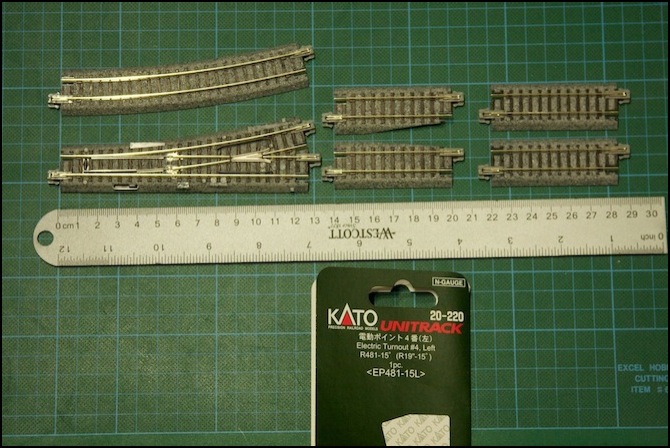
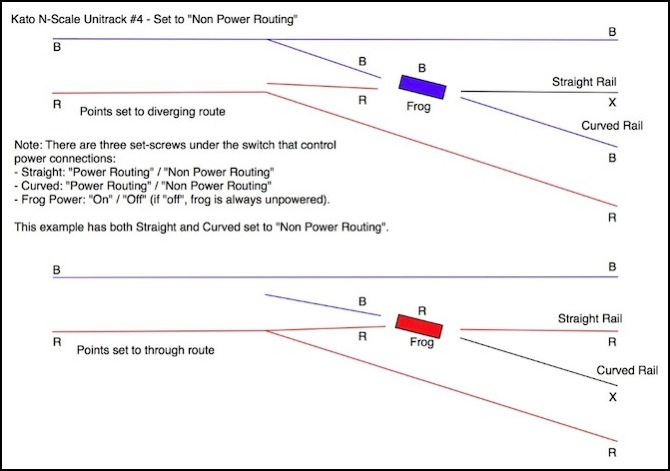
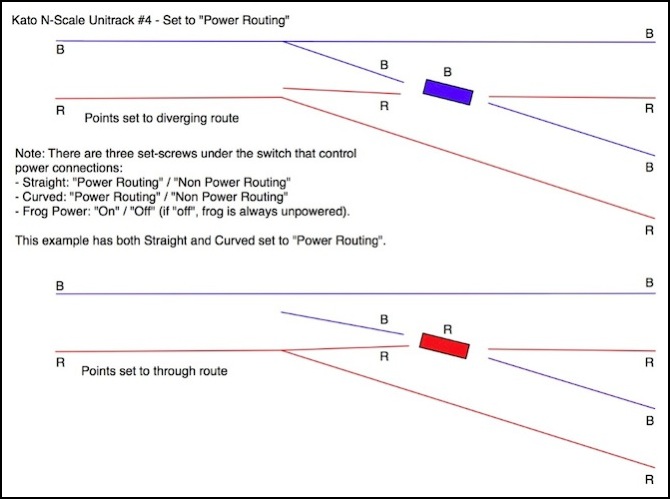
#6: This switch is simpler. It always disables power to the center rail of the unselected route and both point rails are the same polarity. It also does not come with any accessory track segments. However a 64mm straight and an R718 15-degree curve are needed for most uses.
With just a R718-15 curve on the diverging route, this switch provides a 49.5mm offset (for a siding). With a 64mm straight and R718-15 curve it provides a 66mm offset for an island platform.
Two facing switches on parallel tracks of 49.5mm offset with nothing between them provide a crossover with a length of 372mm.
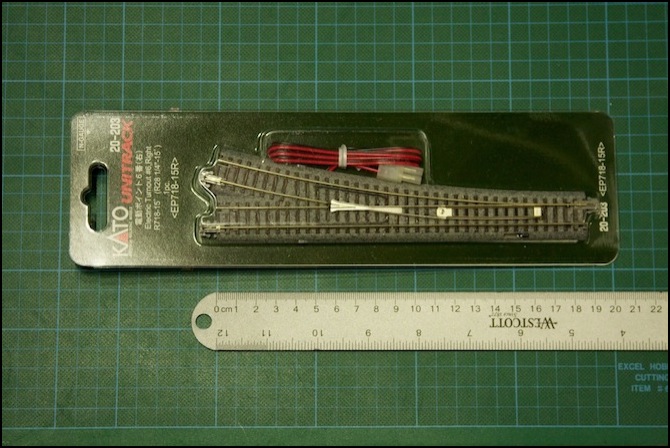
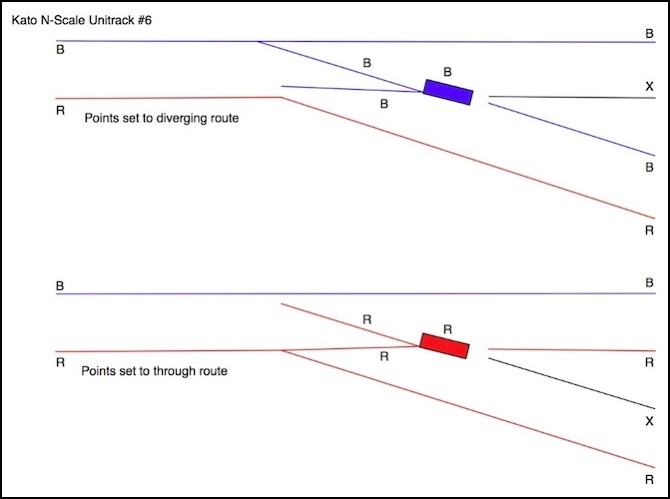
Double-crossover: This switch is long, 310mm, and has two parallel tracks with Kato’s standard double-track offset of 33mm and four switches controlled by a single electrical input. All four switches are either lined for straight or for crossings.
The switch has another quirk: not only are the two mains insulated from each other, but each switch on the same track is insulated from the other (on the same rail). Thus, if you put this element on a track that isn’t a loop, you need to feed power to the rails on both sides.
And, as with other switches, the outer rails are not gapped, so care must be exercised when using it with designs where the polarity could reverse (e.g., return loops).
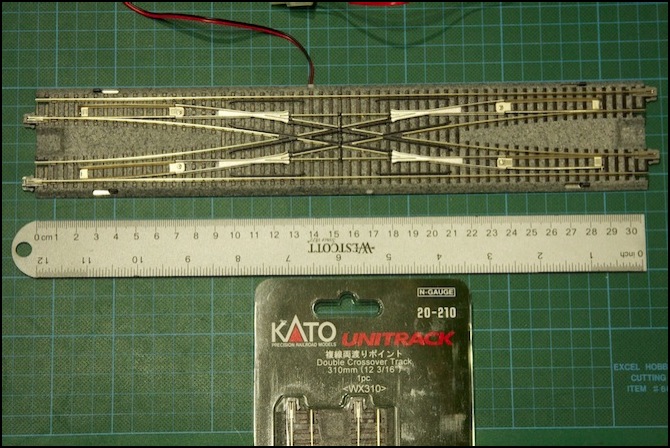
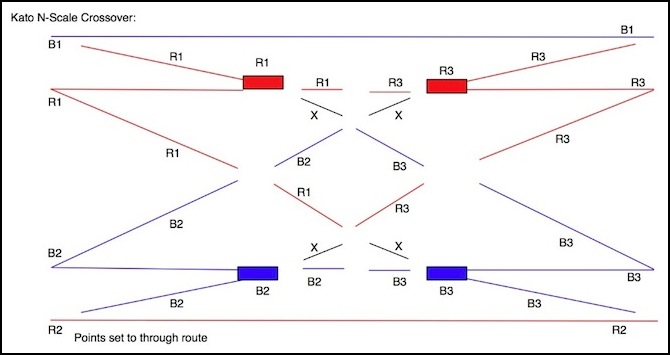
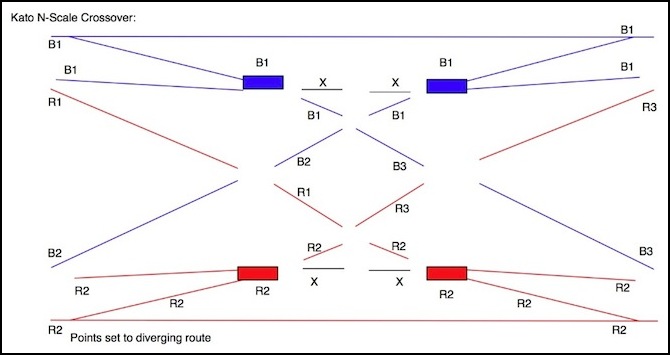
15-degree crossing: This element allows a diverging route from a #6 switch on one track to cross a parallel track at the 49.5mm separation created by an R718 curve used with a #6 switch (i.e., to cross a typical siding). It can’t be used with standard double-track, as the 33mm offset is too close One leg of the crossing is 186mm, and the other (the crossing track) is 192mm.
There are two separate versions of this: the X15R (illustrated below) and X15L. In the X15R, the longer segment diverges to the right as you move along the 186mm segment (and the X15L diverges to the left, of course).
Both routes are electrically isolated (both rails) from each other, but do not block current along the route (i.e., a power feed to the rails is only needed on one side of each route).
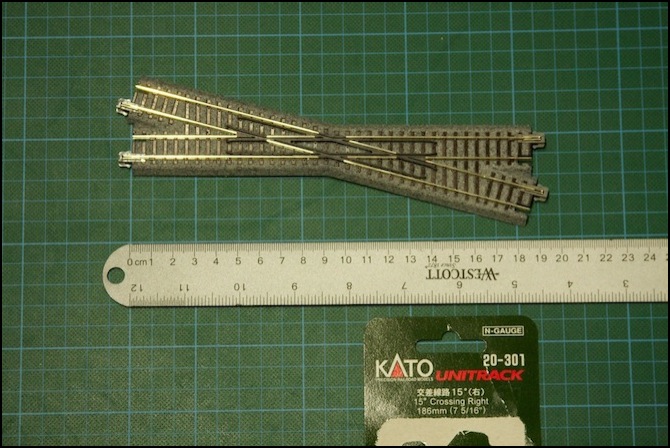
The Single Crossover:
Kato makes a #4 single crossover (in both left-diverging and right-diverging forms) that is designed for use with concrete-tie double-track, and fits in the standard 248 mm length. This switch was actually announced in 2013, but then cancelled and eventually re-released (or “released”) for 2015.
On both, one of the two crossover rails is cut and electrically separated into two elements (why isn’t clear). One interesting characteristic is that the switch is designed to work as a spring switch, allowing a train to run wrong-way through the frog. This requires that the frog be unpowered (via a screw on the underside of the track). The instructions suggest this can only be done with the switch set to non-power-routing (via another screw), but as long as the “X” section were fed appropriate power externally, I don’t think that matters. The instructions also suggest that Power Routing is appropriate for DC power and non-Power-Routing is appropriate for DCC, but I fail to see how that matters. It is probably preferable to always power the “X” section with DCC, but that can also be done via an external feeder.
This is “concrete tie” track, except that the ties under the actual switches are wooden. This is fairly typical of real-world switches on concrete-tie track, as wood absorbs vibrations better. It is not prototypically correct for all railroads however.
While the “Left” version is illustrated below, the “Right” version is identical except for the direction in which the track diverges.
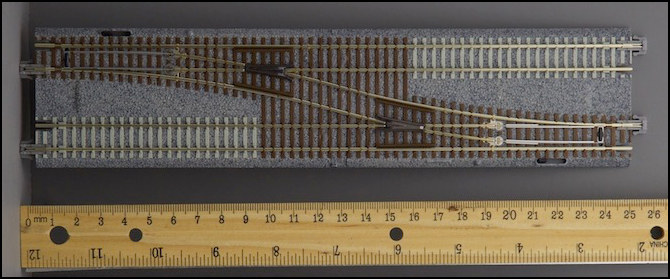
20-231: Right #4 Single Crossing
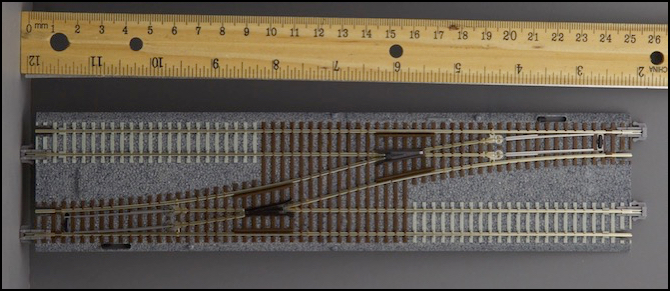
20-230: Left #4 Single Crossing
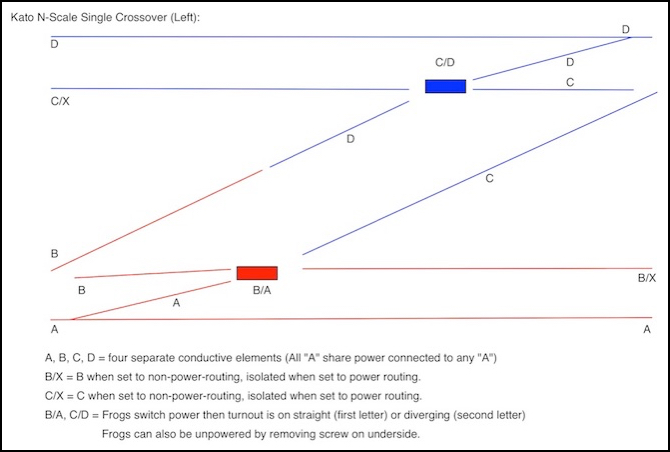
Switches and Crossings
Note: in addition to the part number (20-xxx) Kato also labels these with a descriptive name, e.g, “Electric Turnout #4, Left R481-15° (R19”-15°)” and a short label, e.g., “EP481-15L”, although the short label is usually not used in documentation or order forms.
20-220: Electric Turnout #4, Left R481-15° (R19”-15°)
This is a #4 (R481) left turnout with electric solenoid.
20-221: Electric Turnout #4, Right R481-15° (R19”-15°)
This is a #4 (R481) right turnout with electric solenoid.
20-222: Electric Turnout #2, Y”, R481-15° Curve (new late-2011 in Japan, not yet available in the U.S.)
This is essentially a pair of #4 switches in one, so it can be used with them or with R481-15 curves to split a track around an island platform or for other purposes.
20-202: Electric Turnout #6, Left R718-15° (R28 1/4”-15°)
This is a #6 (R718) left turnout with electric solenoid.
20-203: Electric Turnout #6, Right R718-15° (R28 1/4”-15°)
This is a #6 (R718) right turnout with electric solenoid.
20-210: Double Crossover Track 310mm (12 3/16”)
This is the double-crossover with electric solenoid.
20-230: Concrete Tie Double-Track #4 Single Crossover Turnout 248 mm, Left
This is a single crossover diverging to the left on a 248 mm length of double-track. The track is concrete tie except at the crossover itself, which uses a brown color apparently intended to represent synthetic resin ties rather than wood.
20-231: Concrete Tie Double-Track #4 Single Crossover Turnout 248 mm, Right
This is a single crossover diverging to the right on a 248 mm length of double-track. The track is concrete tie except at the crossover itself, which uses a brown color apparently intended to represent synthetic resin ties rather than wood.
20-300: 15° Crossing Left 186mm (7 5/16”)”
This is the crossing with the long (192mm) segment diverging to the left.
20-301: 15° Crossing Right 186mm (7 5/16”)”
This is the crossing with the long (192mm) segment diverging to the right.
20-320: 90° Crossing 124mm (4 7/8") < X90 >
This is a right-angle crossing. It consists of a center part and four 45.5mm extensions to make each dimension 124mm.
Compact Turnouts
In support of their Unitram line, Kato has also produced a pair of “compact turnouts”: ones with short lengths and sharp radii curves. These aren’t suitable for normal trains with long wheelbases, although they might work for a freight line, particularly one using two-axle older-style Japanese freight cars. Like #4 turnouts, these have screws on the back to change from power-routing to non-power-routing modes. I found the point rails to be very sensitive, with one of two switches just slightly offcenter being enough to derail my Unitram (and anything else taking the diverging route through it).
Note: electrically this is identical to the #4 turnout in function, except that the labels for the screws are correct here, rather than reversed as on the #4. So when set to “power routing” (the default), the inner rail of the non-selected path will be unpowered (i.e., identical to the #4 “non-power routing” diagram up above).
The springs are relatively soft and the frog is non-conductive plastic, and I was able to run my Unitram though the switch when it was set against it with no problems. In other words, it can function as a “spring switch” for a tram line.
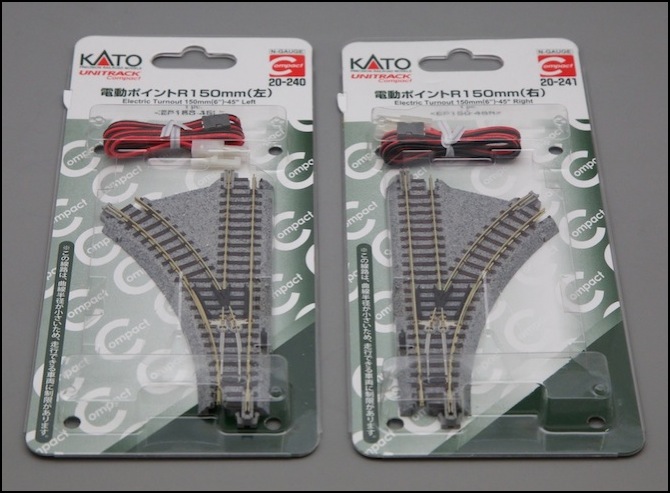
20-240: Compact Electric Turnout 150mm(6”)-45° Left <EP150-45L>
This is a 242mm (9.4”) long straight track with a 45-degree curving turnout of 150mm (6”) radius.
20-241: Compact Electric Turnout 150mm(6”)-45° Right <EP150-45R>
This is a 242mm (9.4”) long straight track with a 45-degree curving turnout of 150mm (6”) radius.
Grade Crossings
Kato makes a 124mm Unitrack “rerailer” that looks like a simple wooden-plank grade crossing, the Unitrack Crossing (20-021). This comes with a couple of plastic bits that can put ramps on the side, or link two or more together for multi-track crossings. It’s not high-tech, but it works.
However, they also used to make (c. 2000) an operating grade crossing with gates and sound, and sold this in two versions, the Japanese style with yellow/black crossbucks and gates (20-650) and the North American style, with red/white gates and white crossbucks (20-650-1). There was also an expansion kit (20-651) to make it a two-track crossing, and cables so the approach sensors could be put further away. It used track switches to sense trains, and as a result wasn’t compatible with DCC. It’s been out of production for a number of years, and going for very high prices when you could find one.
Kato has re-introduced this (at least the Japanese style one, 20-652) in a new DCC-compatible design using IR sensors, which came out in Japan in January 2012. The basic design appears to be the same, except that they eliminated the crossing-keeper’s hut as being obsolete for modern railroads. This is also in the form of a 124mm straight Unitrack element. It has a new double-track adapter (20-653) and new extension cables for the sensors (20-653) which are noted as being incompatible with the older crossings, and vice versa. The sensor tracks appear to be 62mm Unitrack elements with wooden ties. Note that this is still not cheap: the price in Japan is around US$200 for the basic set.
Please be aware that this is a standalone track element; it is not compatible with either the older Diotown road plates or the newer Unitram plates in terms of connectors or geometry.




